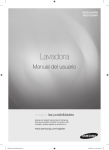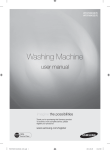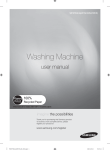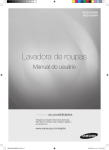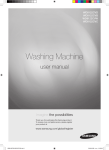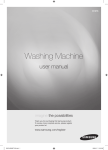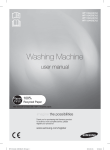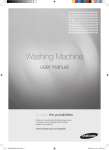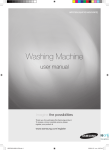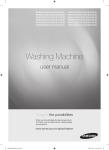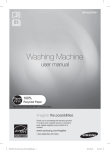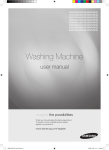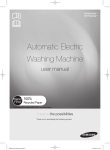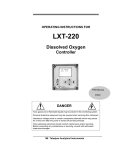Download Samsung WD9102RNW/YCX User Manual
Transcript
WD9102RNW WD9102RNR Washing Machine user manual This manual is made with 100% recycled paper. imagine the possibilities Thank you for purchasing this Samsung product. To receive a more complete service, please register your product at www.samsung.com/register WD9102RNW-02665D_EN.indd 1 2011-07-04 10:44:08 features of your new samsung washing machine Your new washing machine will change the way you feel about doing laundry. From its super-size capacity to its energy efficiency, the Samsung washing machine has all the features to turn a mundane chore into a pleasure. • Diamond Drum - A More Powerful Wash Performance while Protecting your Fabric Provides a much better wash performance than normal drum washers, by using the wash board effect created by the waves of the inside drum. • Air Wash - Sterilization and Deodorization without Water! (selected models) Refresh your favorite clothing simply by using air after you’ve been at a party or have gone out (food, cigarettes). Non-stained clothing no longer needs to be washed, simply refresh them using the 4 available cycles for different fabrics. • Direct Drive Motor As the drum does not utilize belts or gears, vibrations are reduced significantly. This feature ensures that your washer machine is quieter and more durable. • Child Lock The Child Lock function ensures that curious little hands are kept out of your washing machine. This safety feature stops your children from playing with the washing machine, and alerts you when it is activated. • Delay End Delay a cycle for up to 19 hours in one-hour increments and increase the convenience of using your washing machine especially when you have to go out. 2_ features WD9102RNW-02665D_EN.indd Sec1:2 2011-07-04 10:44:54 • Wool Certified The machine has been tested and has passed the required Woolmark Company specifications for machine washable wool products. Fabrics should be washed according to the instructions on the garment label as specified by Woolmark and Samsung. • Wide door Extra wide door aperture for convenient viewing! Easily add and remove laundry, especially for large sized laundry items such as bedding, towels etc. This manual contains important information on the installation, use, and care of your new Samsung washing machine. Refer to it for descriptions of the control panel, instructions on how to use the washing machine, and tips for making the most of its state-of-the-art features and functions. The Troubleshooting section on page 33 tells you what to do if something goes wrong with your new washing machine. features _3 WD9102RNW-02665D_EN.indd Sec1:3 2011-07-04 10:44:55 safety information Congratulations on your new Samsung washer. This manual contains important information on the installation, use and care of your appliance. Please take time to read this manual to take full advantage of your washer’s many benefits and features. WHAT YOU NEED TO KNOW ABOUT SAFETY INSTRUCTIONS Please read this manual thoroughly to ensure that you know how to safely and efficiently operate the extensive features and functions of your new appliance and retain it at a safe place near the appliance for your future reference. Use this appliance only for its intended purpose as described in this instruction manual. Warnings and Important Safety Instructions in this manual do not cover all possible conditions and situations that may occur. It is your responsibility to use common sense, caution, and care when installing, maintaining, and operating your washer. Because these following operating instructions cover various models, the characteristics of your washer may differ slightly from those described in this manual and not all warning signs may be applicable. If you have any questions or concerns, contact your nearest service center or find help and information online at www.samsung.com. IMPORTANT SAFETY SYMBOLS AND PRECAUTIONS What the icons and signs in this user manual mean: WARNING Hazards or unsafe practices that may result in severe personal injury, death and/or property damage. CAUTION Hazards or unsafe practices that may result in personal injury and/or property damage. CAUTION To reduce the risk of fire, explosion, electric shock, or personal injury when using your washer, follow these basic safety precautions: Do NOT attempt. Do NOT disassemble. Do NOT touch. Follow directions explicitly. Unplug the power plug from the wall socket. Make sure the machine is grounded to prevent electric shock. Call the service centre for help. Note These warning signs are here to prevent injury to you and others. Please follow them explicitly. After reading this section, keep it in a safe place for future reference. Read all instructions before using the appliance. As with any equipment using electricity and moving parts, potential hazards exist. To safely operate this appliance, become familiar with its operation and exercise care when using it. 4_ safety information WD9102RNW-02665D_EN.indd Sec2:4 2011-07-04 10:44:55 Do not let children (or pets) play on or in your washing machine. The washing machine door does not open easily from the inside, and children may be seriously injured if trapped inside. WARNING This appliance is not intended for use by persons (including children) with reduced physical, sensory or mental capabilities, or lack of experience and knowledge, unless they have been given supervision or instruction concerning use of the appliance by a person responsible for their safety. Children should be supervised to ensure that they do not play with the appliance. If the plug (power supply cord) is damaged, it must be replaced by the manufacturer or its service agent or a similarly qualified person in order to avoid a hazard. This appliance should be positioned to be accessible to the power plug, the water supply tabs and the drain pipes. For washing machines with ventilation openings in the base, ensure that the opening is not obstructed by carpet or any other obstacles. Use the new hose-sets and old hose-sets should not be reused. safety information _5 WD9102RNW-02665D_EN.indd Sec2:5 2011-07-04 10:44:56 safety information WARNING SEVERE WARNING SIGNS FOR INSTALLATION The installation of this appliance must be performed by a qualified technician or service company. - Failure to do so may result in electric shock, fire, an explosion, problems with the product, or injury. The appliance is heavy, take care upon lifting it Plug the power cord into an AC 220V / 50Hz wall socket or higher and use the socket for this appliance only. In addition, do not use an extension cord. - Sharing a wall socket with other appliances using a power strip or extending the power cord may result in electric shock or fire. - Ensure that the power voltage, frequency and current are the same as those of the product specifications. Failure to do so may result in electric shock or fire. Plug the power plug into the wall socket firmly. Remove all foreign substances such as dust or water from the power plug terminals and contact points using a dry cloth on a regular basis. - Unplug the power plug and clean it with a dry cloth. - Failure to do so may result in electric shock or fire. Plug the power plug into the wall socket in the right direction so that the cord runs towards the floor. - If you plug the power plug into the socket in the opposite direction, the electric wires within the cable may be damaged and this may result in electric shock or fire. Keep all packaging materials well out of the reach of children, as packaging materials can be dangerous to children. - If a child places a bag over its head, it may result in suffocation. When the appliance or power plug or power cord is damaged, contact your nearest service centre. This appliance must be properly grounded. Do not ground the appliance to a gas pipe, plastic water pipe, or telephone line. - This may result in electric shock, fire, an explosion, or problems with the product. - Never plug the power cord into a socket that is not grounded correctly and make sure that it is in accordance with local and national codes. Do not install this appliance near a heater, inflammable material. Do not install this appliance in a humid, oily or dusty location, in a location exposed to direct sunlight and water (rain drops). Do not install this appliance in a location of low temperature - Frost may cause tubes to burst. Do not install this appliance in a location where gas may leak. - This may result in electric shock or fire. Do not use an electric transformer. - It may result in electric shock or fire. Do not use a damaged power plug, damaged power cord or loose wall socket. - This may result in electric shock or fire. Do not pull or excessively bend the power cord. Do not twist or tie the power cord. 6_ safety information WD9102RNW-02665D_EN.indd Sec2:6 2011-07-04 10:44:56 Do not hook the power cord over a metal object, place a heavy object on the power cord, insert the power cord between objects, or push the power cord into the space behind the appliance. - This may result in electric shock or fire. Do not pull the power cord, when unplugging the power plug. - Unplug the power plug by holding the plug. - Failure to do so may result in electric shock or fire. Do not lay the power cord and tubes where you may fall over them. CAUTION CAUTION SIGNS FOR INSTALLATION This appliance should be positioned in such a way that it is accessible to the power plug. - Failure to do so may result in electric shock or fire due to electric leakage. Install your appliance on a level and hard floor that can support its weight. - Failure to do so may result in abnormal vibrations, moves, noise, or problems with the product. WARNING SEVERE WARNING SIGNS FOR USING If the appliance is flooded, Turn off the water & power supply immediately and contact your nearest service centre. - Do not Touch the power plug with wet hands. - Failure to do so may cause electric shock. If the appliance generates a strange noise, a burning smell or smoke, unplug the power plug immediately and contact your nearest service centre. - Failure to do so may result in electric shock or fire. In the event of a gas leak (such as propane gas, LP gas, etc.), ventilate immediately without touching the power plug. Do not touch the appliance or power cord. - Do not use a ventilating fan. - A spark may result in an explosion or fire. Do not let children play in or on the washer. In addition, when disposing of the appliance, remove the washer door lever. - If trapped inside, the child may become trapped and suffocate to death. Make sure to remove the packaging (sponge, styrofoam) attached to the bottom of the washer before using it. safety information _7 WD9102RNW-02665D_EN.indd Sec2:7 2011-07-04 10:44:56 safety information Do not wash items contaminated with gasoline, kerosene, benzene, paint thinner, alcohol or other flammable or explosive substances. - This may result in electric shock, fire or an explosion. Do not open the washer door by force while it is operating (high-temperature washing/ drying/spinning). - Water flowing out of the washer may result in burns or cause the floor to be slippery. This may result in injury. - Opening the door by force may result in damage to the product or injury. Do not insert your hand under the washer. - This may result in injury. Do not touch the power plug with wet hands. - This may result in electric shock. Do not turn the appliance off by unplugging the power plug while an operation is in progress. - Plugging the power plug into the wall socket again may cause a spark and result in electric shock or fire. Do not let children or infirm persons use this washer unsupervised. Do not let children climb in the appliance. - Failure to do so may result in electric shock, burns or injury. Do not insert your hand or a metal object under the washer while it is operating. - This may result in injury. Do not unplug the appliance by pulling at the power cord, always grip plug firmly and pull straight out from the outlet. - Damage to the cord may cause short-circuit, fire and/or electric shock. Do not attempt to repair, disassemble, or modify the appliance yourself. - Do not use any fuse (such as cooper, steel wire, etc.) other than the standard fuse. - When repairing or reinstalling the appliance is required, contact your nearest service centre. - Failure to do so may result in electric shock, fire, problems with the product, or injury. If the water supply hose comes loose from the Water tap and floods the appliance, unplug the power plug. - Failure to do so may result in electric shock or fire. Unplug the power plug when the appliance is not being used for long periods of time or during a thunder/lightning storm. - Failure to do so may result in electric shock or fire. 8_ safety information WD9102RNW-02665D_EN.indd Sec2:8 2011-07-04 10:44:57 CAUTION CAUTION SIGNS FOR USING When the washer is contaminated by a foreign substance such as detergent, dirt, food waste, etc., unplug the power plug and clean the washer using a damp and soft cloth. - Failure to do so may result in discolouration, deformation, damage or rust. The front glass may be broken by a strong impact. Take care when using the washer. - When the glass is broken, it may result in injury. After a water supply failure or when reconnecting the water supply hose, open the Water Tap slowly. Open the Water Tap slowly after a long period of non-use. - The air pressure in the water supply hose or the water pipe may result in damage to a part or in water leakage. If a drain error occurs during an operation, check if there is a draining problem. - If the washer is used when it is flooded because of a draining problem, it may result in electric shock or fire due to electric leakage. Insert the laundry into the washer completely so that laundry does not get caught in the door. - If laundry gets caught in the door, it may result in damage to the laundry or the washer, or result in water leakage. Ensure that the Water Tap is turned off when the washer is not being used. - Ensure that the screw on the water supply hose connector is properly tightened. - Failure to do so may result in property damage or injury. Take care that the rubber seal and the front door glass are not contaminated by a foreign substance (e.g. waste, thread, hair, etc.) - If a foreign substance is caught in the door or the door is not completely closed, it may cause a water leakage. Open the Water Tap and check if the water supply hose connector is firmly tightened and that there is no water leaking before using the product. - If the screws or the water supply hose connector are loose, it may result in water leakage. safety information _9 WD9102RNW-02665D_EN.indd Sec2:9 2011-07-04 10:44:57 safety information Do not stand on top of the appliance or place objects (such as laundry, lighted candles, lighted cigarettes, dishes, chemicals, metal objects, etc.) on the appliance. - This may result in electric shock, fire, problems with the product, or injury. Do not spray volatile material such as insecticide onto the surface of the appliance. - As well as being harmful to humans, it may also result in electric shock, fire or problems with the product. Do not place an object that generates a electromagnetic field near the washer. - This may result in injury due to a malfunction. Since the water drained during a high-temperature wash or drying cycle is hot, do not touch the water. - This may result in burns or injury. Do not wash, spin or dry water-proof seats, mats or clothing (*) unless your appliance has a special program for washing these items. - Do not wash thick, hard mats even if the washer mark is on the care label. - This may result in injury or damage to the washer, walls, floor or clothing due to abnormal vibrations. * Woollen bedding, rain covers, fishing vests, ski pants, sleeping bags, diaper covers, sweat suits, and bicycle, motor cycle, car covers, etc. Do not operate the washer when the detergent box is removed. - This may result in electric shock or injury due to water leakage. Do not touch the inside of the tub during or just after drying as it is hot. - This may result in burns. Do not insert your hand into the detergent box after opening it. - This may result in injury as your hand may be caught by the detergent input device. Do not place any objects (such as shoes, food waste, animals) other than laundry into the washer. - This may result in damage to the washer, or injury and death in the case of pets due to the abnormal vibrations. Do not press the buttons using sharp objects such as pins, knifes, fingernails, etc. - This may result in electric shock or injury. Do not wash laundry contaminated by oils, creams or lotions usually found in skincare shops or massage clinics. - This may result in the rubber seal becoming deformed and water leakage. Do not leave metal objects such as a safety pin or hair pin, or bleach in the tub for long periods of time. - This may cause the tub to rust. - If rust starts appearing on the surface of the tub, apply a cleansing agent (neutral) to the surface and use a sponge to clean it. Never use a metal brush. Do not use dry cleaning detergent directly and do not wash, rinse, or spin laundry contaminated by dry cleaning detergent. - This may result in spontaneous combustion or ignition due to the heat of the oxidation of the oil. Do not use hot water from water cooling/heating devices. - This may result in problems with the washer. 10_ safety information WD9102RNW-02665D_EN.indd Sec2:10 2011-07-04 10:44:57 Do not use natural hand-washing soap for the washer. - If it hardens and accumulates inside the washer, it may result in problems with the product, discolouration, rust or bad odors. Do not wash large laundry items such as bedding in the washing net. - Place socks and brassieres into the washing net and wash them with the other laundry. - Failure to do so may result in injury due to abnormal vibrations. Do not use hardened detergent. - If it accumulates inside the washer, it may result in water leakage. For washing machines with ventilation openings in the base, ensure that the opening is not obstructed by carpet or any other obstacles. Make sure that the pockets of all clothing to be washed are empty. - Hard, sharp objects, such as coins, safety pins, nails, screws, or stones can cause extensive damage to the appliance. Do not wash clothing with large buckles, buttons, or other heavy metal. WARNING SEVERE WARNING SIGNS FOR CLEANING Do not clean the appliance by spraying water directly onto it. Do not use benzene, thinner or alcohol to clean the appliance. - This may result in discolouration, deformation, damage, electric shock or fire. Before cleaning or performing maintenance, unplug the appliance from the wall socket. - Failure to do so may result in electric shock or fire. safety information _11 WD9102RNW-02665D_EN.indd Sec2:11 2011-07-04 10:44:57 contents SETTING UP YOUR WASHING MACHINE 13 14 14 15 15 15 15 15 Checking the parts and the control panel Meeting installation requirements Water Supply Drain Flooring Surrounding temperature Alcove or closet installation Installing your washing machine 21 21 22 24 24 24 25 26 27 29 29 29 Washing for the first time Basic instructions Using the control panel Child lock Delay end Stop&Add Air wash Washing clothes using cycle selector Washing clothes manually Detergent and additives information Which detergent to use Detergent drawer CLEANING AND MAINTAINING YOUR WASHING MACHINE 30 30 30 31 31 32 32 32 Draining the washing machine in an emergency Cleaning the exterior Cleaning the detergent drawer and drawer recess Cleaning the debris filter Cleaning the water hose mesh filter Repairing a frozen washing machine Storing your washing machine TROUBLESHOOTING AND INFORMATION CODES 33 34 Check these points if your washing machine... Information codes 33 35 CYCLE CHART 35 Cycle chart APPENDIX 36 36 36 37 Fabric care chart Protecting the environment Declaration of conformity Specifications 13 WASHING A LOAD OF LAUNDRY 21 36 12_ contents WD9102RNW-02665D_EN.indd Sec3:12 2011-07-04 10:44:57 setting up your washing machine CHECKING THE PARTS AND THE CONTROL PANEL Carefully unpack your washing machine, and make sure you’ve received all of the parts shown below. If your washing machine was damaged during shipping, or if you do not have all of the parts, contact Samsung Customer Service or your Samsung dealer. 01 SETTING UP Be sure to have your installer follow these instructions closely so that your new washing machine works properly and so that you’re not at risk of injury when doing laundry. Option Work top Detergent drawer Control panel Plug Door Drain hose Debris filter Adjustable feet Emergency drain tube Filter Cover (use for the lower bolt hole) Spanner Bolt hole covers Water supply hose Hose guide Drain hose User manual setting up your new washing machine _13 WD9102RNW-02665D_EN.indd Sec4:13 2011-07-04 10:44:57 setting up your washing machine MEETING INSTALLATION REQUIREMENTS WARNING Never use an extension cord. Use only the power cord that comes with your washing machine. When preparing for installation, ensure that your power supply offers: • AC 220V / 50Hz fuse or circuit breaker • Individual branch circuit serving only your washing machine Your washing machine must be grounded. If your washing machine malfunctions or breaks down, grounding will reduce the risk of electric shock by providing a path of least resistance for the electric current. Your washing machine comes with a power cord having a three-prong grounding plug for use in a properly installed and grounded outlet. Never connect the ground wire to plastic plumbing lines, gas lines, or hot water pipes. Improperly connecting the equipment-grounding conductor can result electrical shock. Check with a qualified electrician or serviceman if you are unsure if the washing machine is properly grounded. Do not modify the plug provided with the washing machine. If it does not fit the outlet, have a proper outlet installed by a qualified electrician. Water Supply Your washing machine will fill properly when your water pressure is 50 kPa ~ 800 kPa. Water pressure less than 50 kPa may cause water valve failure, not allowing the water valve to shut off completely. Or, it may take the washing machine longer to fill than what the controls allow, resulting in your washing machine turning off. (A fill-time limit, designed to prevent overflows/ flooding if an internal hose becomes loose, is built into the controls.) The water taps must be within 4 feet (122cm) of the back of your washing machine for the provided inlet hoses provided to reach your washing machine. Most plumbing supply stores sell inlet hoses of various lengths up to 10 feet (305 cm) long. You can reduce the risk of leaks and water damage by: • Making water taps easily accessible. • Turning off taps when the washing machine is not in use. • Periodically checking for leaks at water inlet hose fittings. WARNING Before using your washing machine for the first time, check all connections at the water valve and taps for leaks. 14_ setting up your new washing machine WD9102RNW-02665D_EN.indd Sec4:14 2011-07-04 10:44:58 Drain Samsung recommends a standpipe height of 65cm. The drain hose must be routed through the drain hose clip to the standpipe. The standpipe must be large enough to accept the outside diameter of the drain hose. The drain hose is attached at the factory. For best performance, your washing machine must be installed on a solidly constructed floor. Wood floors may need to be reinforced to minimize vibration and/or unbalanced loads. Carpeting and soft tile surfaces are contributing factors to vibrations and the tendency for your washing machine to move slightly during the spin cycle. 01 SETTING UP Flooring Never install your washing machine on a platform or poorly supported structure. Surrounding temperature Do not install your washing machine in areas where water may freeze, since your washing machine always retains some water in its water valve, pump, and hose areas. Frozen water in the lines can cause damage to belts, the pump, and other components. Alcove or closet installation To operate safely and properly, your new washing machine requires minimum clearances of: Sides – 25 mm Rear – 51 mm Top – 25 mm Front – 465 mm If both the washing machine and a dryer are installed together, the front of the alcove or closet must have at least 465 mm unobstructed air opening. Your washing machine alone does not require a specific air opening. INSTALLING YOUR WASHING MACHINE STEP 1 Selecting a location Before you install the washing machine, make sure the location: • • • • • • Has a hard, level surface without carpeting or flooring that may obstruct ventilation Is away from direct sunlight Has adequate ventilation Will not be freezing (below 32 ˚F or 0 ˚C) Is away from heat sources such as oil or gas Has enough space so that the washing machine doesn’t stand on its power cord setting up your new washing machine _15 WD9102RNW-02665D_EN.indd Sec4:15 2011-07-04 10:44:58 setting up your washing machine STEP 2 Removing the shipping bolts Before installing the washing machine, you must remove the five shipping bolts from the back of the unit. 1. Loosen all the bolts with the supplied wrench. Option 2. Hold the bolt with the spanner and pull it through the wide section of the hole. Repeat for each bolt. 3. Fill the holes with the supplied plastic covers. 4. Store the shipping bolts away safely in case you have to move the washing machine in the future. WARNING Packaging materials can be dangerous to children; keep all packaging material (plastic bags, polystyrene, etc.) well out of the reach of children. 16_ setting up your new washing machine WD9102RNW-02665D_EN.indd Sec4:16 2011-07-04 10:44:59 STEP 3 Adjusting the levelling feet When installing your washing machine, ensure that the power plug, the water supply and the drain are easily accessible. 01 SETTING UP 1. Slide the washing machine into position. 2. Level your washer by turning the adjustable nut, as shown in the figure. Locking nut Adjustable nut 3. When your washing machine is level, tighten the locking nut using the (-) screwdriver. STEP 4 Connecting the water and drain Connecting the water supply hose 1. Take the L-shaped arm fitting for the cold water supply hose and connect it to the cold water supply intake on the back of the machine. Tighten by hand. Option The water supply hose must be connected to the washing machine at one end and to the water tap at the other. Do not stretch the water supply hose. If the hose is too short, replace the hose with a longer, high pressure hose. 2. Connect the other end of the cold water supply hose to your sink’s cold water tap and tighten it by hand. If necessary, you can reposition the water supply hose at the washing machine end by loosening the fitting, rotating the hose, and retightening the fitting. For selected models with an additional hot water intake: 1. Take the red L-shaped arm fitting for the hot water supply hose and connect it to the hot water supply intake on the back of the machine. Tighten by hand. 2. Connect the other end of the hot water supply hose to your sink’s hot water tap and tighten it by hand. 3. Use a Y-piece if you only want to use cold water. setting up your new washing machine _17 WD9102RNW-02665D_EN.indd Sec4:17 2011-07-04 10:44:59 setting up your washing machine Connecting the water supply hose (selected models) 1. Remove the adaptor from the water supply hose. Adaptor Water supply hose 2. First, using a ‘+’ type screwdriver, loosen the four screws on the adaptor. Next, take the adaptor and turn part (2) following the arrow until there is a 5 mm gap. 1 5 mm 2 3. Connect the adaptor to the water tap by tightening the screws firmly while lifting the adaptor upwards. Turn part (2) following the arrow and connect (1) and (2). Water tap 1 2 4. Connect the water supply hose to the adaptor. When you release part (3), the hose automatically connects to the adaptor making a ‘click’ sound. After you have connected the water supply hose to the adaptor, ensure that it is connected correctly by pulling the water supply hose downwards. 3 5. Connect the other end of the water supply hose to the inlet water valve at the rear of the washing machine. Screw the hose clockwise all the way in. Option 18_ setting up your new washing machine WD9102RNW-02665D_EN.indd Sec4:18 2011-07-04 10:45:00 6. Turn on the water supply and ensure that no water leaks from the water valve, tap or adaptor. If there is a water leaks, repeat the previous steps. • Do not use your washing machine if there is a water leak. This may cause electrical shock or injury. ✗ ✗ If the water tap has a screw type tap, connect the water supply hose to the tap as shown. 01 SETTING UP WARNING Use the most conventional type of tap for the water supply. In case the tap is square or too big, remove the spacing ring before inserting the tap into the adaptor. setting up your new washing machine _19 WD9102RNW-02665D_EN.indd Sec4:19 2011-07-04 10:45:00 setting up your washing machine Connecting the drain hose The end of the drain hose can be positioned in three ways: 1. Over the edge of a wash basin: The drain hose must be placed at a height of between 60 and 90 cm. To keep the drain hose spout bent, use the supplied plastic hose guide. Secure the guide to the wall with a hook or to the tap with a piece of string to prevent the drain hose from moving. 60 ~ 90 cm Drain hose Hose guide 2. ln a sink drain pipe branch: The drain pipe branch must be above the sink siphon so that the end of the hose is at least 60 cm above the ground. 3. ln a drain pipe: We recommend using a 65 cm high vertical pipe; it must be no shorter than 60 cm and no longer than 90 cm. STEP 5 Powering your washing machine Plug the power cord into a wall sockets, an 220V / 50Hz approved electrical outlet protected by a fuse or circuit breaker. (For more information on electrical and grounding requirements, see page 14.) 20_ setting up your new washing machine WD9102RNW-02665D_EN.indd Sec4:20 2011-07-04 10:45:01 washing a load of laundry With your new Samsung washing machine, the hardest part of doing laundry will be deciding which load to wash first. WASHING FOR THE FIRST TIME 1. Press the Power button. 2. Add a little detergent to the detergent compartment the detergent drawer. 3. Turn on the water supply to the washing machine. 4. Press the Start/Pause button. in This will remove any water that might be left over in the machine from the manufacturer’s test run. Compartment Compartment Compartment : Detergent for prewash, or starch. : Detergent for the main wash, water softener, pre-soaking agent, bleach and stain removal product. : Additives, e.g. fabric softener or former (fill no higher than lower edge (MAX) of “A”) 02 WASHING A LOAD OF LAUNDRY Before washing laundry for the first time, you must run a complete empty cycle (i.e. no laundry). BASIC INSTRUCTIONS 1. Load your laundry into the washing machine. WARNING Do not overload the washing machine. To determine the load capacity for each type of laundry, refer to the chart on page 28. • Make sure that laundry is not caught in the door, as this may cause a water leak. • Washing detergent may remain in the front rubber part of the washer after a wash cycle. Remove any remaining detergent, as they may cause a water leak. • Do not touch the door glass while your washing machine is running or it may be hot. • Do not open the detergent drawer or the debris filter while your washing machine is running or you might be exposed to hot water or steam. • Do not wash water-proofed items in normal cycle except outdoor care program. 2. 3. 4. 5. Close the door until it latches. Turn the power on. Add detergent and additives to the dispenser drawer. Select the appropriate cycle and options for the load. The Wash Indicator light will illuminate and the estimated cycle time will appear in the display. 6. Press the Start/Pause button. washing a load of laundry _21 WD9102RNW-02665D_EN.indd Sec5:21 2011-07-04 10:45:01 washing a load of laundry USING THE CONTROL PANEL 1 1 2 DIGITAL GRAPHIC DISPLAY 3 4 5 6 7 8 9 10 11 12 Displays the remaining wash cycle time, all cycle information, and error messages. Select the tumble pattern and spinning speed for the cycle. For detailed information, refer to “Washing clothes using the cycle selector”(see page 26). 2 CYCLE SELECTOR Cottons - For averagely or lightly soiled cottons, bed linen, table linen, underwear, towels, shirts, etc. Soak - This is the course that completely removes dirt from laundry using the soak function. Boil - This course is appropriate to wash underwear we change everyday, strong dirt removal and sterilization is performed simultaneously. Blanket - Cotton bedding, bed linen, bed sheet, duvet cover, pillow cover etc. Clean Tub - Use this function to maintain wash tub clean and sanitary. Air Wash - This course is useful for removing bad odors. Turning the Cycle Selector cycles through the following operating modes. Knit Æ Coat Æ Bedding Æ Allergy Free Towel - This course is useful for washing towels effectively. Wool - Only for machine-washable wool. A load should be less than 2.0 kg. • The wool course washes the laundry using gentle cradling actions. During the wash, the gentle cradling and soaking actions are continued to protect the wool fibers from shrinkage / distortion and for a super gentle clean. This stop operation is not a problem. • Neutral detergent is recommended for wool course, for improved washing results and for improved care of the wool fibers. The wool wash cycle of this machine has been approved by Woolmark for the washing of machine-washable Woolmark products provided that the products are washed according to the instructions on the garment label and those issued by the manufacturer of this washing machine, MXXXXX (Certificate Number issued by I.W.S. Nominee Co., Ltd.) Quick - This course is used for small amounts of laundry, relatively clean laundry, or frequently used laundry in a short period of time. 22_ washing a load of laundry WD9102RNW-02665D_EN.indd Sec5:22 2011-07-04 10:45:02 Press this button to select pre-wash. Pre-wash means a preliminary wash that is performed for 10 minutes before the main wash. Pre-wash is effective for highly soiled laundry. Pre-wash is only available for: Cottons, Blanket, and Towel. 4 DELAY END SELECTION BUTTON Press this button repeatedly to cycle through the available Delay End options (max 19 hours in one hour increments). The hour displayed indicates the time when the wash cycle will be finished. 5 TEMPERATURE SELECTION BUTTON Press this button repeatedly to cycle through the available water temperature options: (Cold Water, 30 ˚C, 40 ˚C, 60 ˚C and 95 ˚C). 6 RINSE SELECTION BUTTON Press this button to add additional rinse cycles. The maximum number of rinse cycles is five. 7 SPIN SELECTION BUTTON Press the button repeatedly to cycle through the available speeds for the spin cycle. “No spin ” - The laundry remains in the drum and no spin cycle is performed after the final drain. 8 DRY SELECTION BUTTON Pressing the button cycles through the following options. Cupboard Æ Extra Æ Iron Æ Light Æ Time (30min Æ 1:00min Æ 1:30min Æ 2:00min Æ 2:30min) “Cupboard” - Select to dry laundry automatically by detecting the amount and weight of the laundry. Select this to dry cotton clothing such as cotton trousers, T-shirts, and cotton underwear. “Extra” - Select this to dry cotton clothing completely. (Thick clothes such as blue jeans, towels, sports clothes, etc.) “Iron” - Finishes the dry cycle in a moist state appropriate for Ironing. “Light” - Dry clothing which may become deformed at high temperatures at a low temperature. (Mixed fabrics and synthetic fibers such as polyester and nylon.) “Time” - Dry the laundry for the specified period of time. 02 WASHING A LOAD OF LAUNDRY 3 PREWASH SELECTION BUTTON • You must avoid washing laundry that may not be dried as it may be deformed even at low temperatures. • The Normal, Extra, Iron and Light Dry options detect the weight of the laundry in order to display an accurate drying time and dry them more completely. • The drying conditions may differ depending on the type and the amount of laundry. 9 STOP&ADD SELECTION BUTTON Select this to add the laundry amid the process (See “Stop&Add” on page 24). 10 STEAM WASH SELECTION BUTTON Press this button to use steam. Steam Care is available with Quick Wash, Cottons, Soak, Towels, Blanket, Boil cycles. For heavily soiled, colorfast garments. Steam care improves stain treatment and use less water of each cycle. 11 START/PAUSE SELECTION BUTTON Press to pause and restart a cycle. 12 POWER BUTTON Press it once to turn your washing machine on, press it again to turn your washing machine off. If the washing machine is left on for more than 10 minutes without any buttons being touched, the power automatically turns off. washing a load of laundry _23 WD9102RNW-02665D_EN.indd Sec5:23 2011-07-04 10:45:03 washing a load of laundry Child lock The Child Lock function allows you to lock the buttons so that the wash cycle you’ve chosen can’t be changed. Activating/Deactivating If you want to activate or deactivate the Child Lock function, press the Temp. and Rinse buttons at the same time for 3 seconds. “Child Lock ” will be lit when this feature is activated. When the Child Lock function is activated, only the Power button works. The Child Lock function remains on even after the power is turned on and off or after the disconnecting and reconnecting the power cord. 3 SEC. Delay end You can set the washing machine to finish your wash automatically at a later time, choosing a delay of max 19 hours (in 1 hour increments). The hour displayed indicates the time at which the wash will be finished. 1. Manually or automatically set your washing machine according to the type of laundry you are washing. 2. Press the Delay End button repeatedly until the delay time is set. 3. Press the Start/Pause button. The “Delay End” indicator will be lit, and the clock will begin counting down until it reaches the set time. 4. To cancel a Delay End function, press the Power button and then turn the washing machine on again. Stop&Add When the washing machine is working, the door is locked, and the “Stop&Add” lamp is off, you will not be able to add laundry. You can only add laundry when the Stop&Add lamp is illuminated. 1. Press the Stop&Add button. The washing machine will automatically pause. 2. Wait about 30 seconds and check the state of “Stop&Add” lamp. • Blinking: The water in the washing machine is drained down to the safety level for the additional laundry to be added. • Off: Adding laundry is possible. 3. Add the laundry. 4. Press the Start/Pause button. • Avoid adding laundry when the machine has foamed up or is filled with water. Otherwise, the foam or water may leak from the door. Check before opening the door. • We recommend that you select the Stop&Add function 5 minutes before a cycle is performed. • If the internal temperature is higher than 60 ˚C during the wash cycle or 95 ˚C during the drying cycle, the Stop&Add function cannot be selected. • Do not open the door by force as it may result in injury or damage the washer. WARNING 24_ washing a load of laundry WD9102RNW-02665D_EN.indd Sec5:24 2011-07-04 10:45:03 Air wash MODE CYCLE TIME Knit 20 min Coat 26 min Bedding 40 min Allergy Free 1:18 min • Allergy Free: Select this program to sterilize your laundry, for example against ticks. Since the temperature rises above 90 ˚C, clothes susceptable to heat may be deformed or damaged. • Bedding: This program includes cotton bedding. However, nylon laundry may become deformed or damaged. • You may experience heat when touching laundry after the Air wash course is complete. (Average 40 ˚C ~ 48 ˚C) • When one of these options has been selected, no other button can be selected and you can only select a maximum delay end time of 19 hours. 4. Close the door and press the Start/Pause button. 02 WASHING A LOAD OF LAUNDRY Air wash can refresh laundry without using water owing to its powerful airing system. Clothing that can be refreshed includes woolen coats, cotton or down jumpers, sweaters and suits. (Two items or less (less then 1 kg) 1. Open the door, place the laundry into the washer and close the door. 2. Press the Power button. 3. Select Air wash by turning the Cycle Selector. • Turn the Cycle Selector to cycle through the following programs: Knit, Coat, Bedding, Allergy Free, ... • When there is water in the tub, Air wash cannot be selected. Drain the water and select Air wash. • Press the Start/Pause or Power button to remove the laundry. • Fragrance or dryer sheets can be used with Air wash programs to add fragrance to your refreshed laundry (one sheet per one or two items). Avoid Air Washing the following clothes: • Sensitive clothes made of leather, mink, fur, silk, etc. • Underwear trimmed with lace, ‘glued’ doll cushions, and dress suits may have their decorations loosened. • Clothes trimmed with buttons can cause them to break. • Starchy clothes can become deformed. Avoid using the following clothes for the Allergy Free program: • Hard bedding such as a wooden pillows (neck-rest) - Pillows or blankets filled with plastic or starch rather than cotton - Electric blankets • Furry blankets • Bulky blankets washing a load of laundry _25 WD9102RNW-02665D_EN.indd Sec5:25 2011-07-04 10:45:04 washing a load of laundry Washing clothes using cycle selector Your new washing machine makes washing clothes easy, using Samsung’s “Fuzzy Control” automatic control system. When you select a wash program, the machine will set the correct temperature, washing time, and washing speed. 1. 2. 3. 4. 5. 6. Turn on your sink’s water tap. Press the Power button. Open the door. Load the articles one at a time loosely into the drum, without overfilling it. Close the door. Add detergent, softener, and pre-wash detergent (if necessary) into the appropriate compartments. Pre-wash is only available when selecting the Cottons, Soak, Boil, Blanket, Towel and Quick cycles. It is only necessary if your clothing is heavily soiled. 7. Use the Cycle Selector to select the appropriate cycle according to the type of material: Cottons, Soak, Boil, Blanket, Clean Tub, Towel, Wool, Quick, Cottons. The relevant indicators will illuminate on the control panel. 8. At this time, you can control the wash temperature, the amount of rinses, the spinning speed, and the delay time by pressing the appropriate option button. 9. Press the Start/Pause button and the wash will begin. The process indicator will light up and the remaining time for the cycle will appear in the display. Pause Option Within 5 minutes of starting a wash, it is possible to add/remove laundry items. 1. Press the Start/Pause button to unlock the door. The door cannot be opened when the water is too HOT or the water level is too HIGH. 2. After closing the door, press the Start/Pause button to restart the wash. When the cycle is finished: After the total cycle has finished, the power will turn off automatically. 1. Open the door. 2. Remove laundry. 26_ washing a load of laundry WD9102RNW-02665D_EN.indd Sec5:26 2011-07-04 10:45:05 Washing clothes manually 02 WASHING A LOAD OF LAUNDRY You can wash clothes manually without using the Cycle Selector. 1. Turn the water supply on. 2. Press the Power button on the washing machine. 3. Open the door. 4. Load the articles loosely into the drum one at a time, without overfilling it. 5. Close the door. 6. Add detergent and, if necessary, softener or prewash detergent, into the appropriate compartments. 7. Press the Temp. button to select the temperature. (Cold Water, 30 ˚C, 40 ˚C, 60 ˚C and 95 ˚C) 8. Press the Rinse button to select the required number of rinse cycles. The maximum number of rinse cycles is five. The wash duration is increased accordingly. 9. Press the Spin button to select the spin speed. 10. Press the Delay End button repeatedly to cycle through the available Delay End options (max 19 hours in one hour increments). The hour displayed indicates the time at which the wash will be finished. 11. Press the Start/Pause button and the machine will begin the cycle. washing a load of laundry _27 WD9102RNW-02665D_EN.indd Sec5:27 2011-07-04 10:45:05 washing a load of laundry LAUNDRY GUIDELINES Follow these simple guidelines for the cleanest laundry and the most efficient wash. Always check the Care label on clothing before washing. Sort and wash your laundry according to the following criteria: • Care Label: Sort laundry into cottons, mixed fibres, synthetics, silks, wools and rayons. • Colour: Divide whites and colours. Wash new colour items separately. • Size: Placing items of different sizes in the same load will improve the wash action. • Sensitivity: Wash delicate items separately, using the Wool cycle for pure, new woollen items, curtains and silk articles. Check the labels on the items you are washing or refer to the fabric care chart in the appendix. Emptying pockets Before each wash, empty all the pockets of your laundry. Small, irregularly shaped hard objects, such as coins, knives, pins, and paperclips could damage your washing machine. Do not wash clothing with large buckles, buttons, or other heavy metal objects. Metal on clothing may damage your clothing as well as the tub. Turn clothing with buttons and embroidered clothes inside out before washing them. If zips of pants and jackets are open while washing, the spin basket may be damaged. Zips should be closed and fixed with a string before washing. Clothing with long strings may become entangled with other clothes damaging them. Be sure to fix the strings before starting the wash. Prewashing cotton Your new washing machine, combined with modern detergents, will give perfect washing results, thus saving energy, time, water and detergent. However, if your cotton is particularly dirty, prewash with a protein-based detergent. Determining the load capacity Do not overload the washing machine or your laundry may not wash properly. Use the chart below to determine the load capacity for the type of laundry you are washing. Fabric Type Load Capacity Model WD9102RNW/WD9102RNR Cottons 12.0 kg Boil 7.0 kg Towel / Quick Blanket 3.0 kg 1 sheet [Within 3 kg] Wool 5.0 kg Dry 7.0 kg When the laundry is unbalanced (“UE” lights up on the display), redistribute the load. Make sure to insert brassieres (water washable) into a laundry net (to be purchased additionally). • The metal parts of the brassieres may break through the material and damage the laundry. Therefore make sure to place them inside a fine laundry net. • Small, light clothing such as socks, gloves, stockings and handkerchiefs may become caught around the door. Place them inside a fine laundry net. CAUTION Do not wash the laundry net by itself without other laundry. This may cause abnormal vibrations that could move the washing machine and cause an accident resulting in injury. 28_ washing a load of laundry WD9102RNW-02665D_EN.indd Sec5:28 2011-07-04 10:45:05 DETERGENT AND ADDITIVES INFORMATION Which detergent to use Do not use detergent that has hardended or solidified as the detergent may remain in the rinse cycle. It may cause your washing machine to not rinse properly or result in the overflow becoming blocked. Detergent drawer Your washing machine has separate compartments for dispensing detergent and fabric softener. Add all laundry additives to the correct compartment before starting your washing machine. Do NOT open the detergent drawer when your washing machine is running. 02 WASHING A LOAD OF LAUNDRY The type of detergent you should use is based on the type of fabric (Cottons, synthetic, Boil items, wool), colour, wash temperature, and degree of soiling. Always use “low suds” laundry detergent, which is designed for automatic washing machines. Follow the detergent manufacturer’s recommendations based on the weight of the laundry, the degree of soiling, and the hardness of the water in your area. If you do not know how hard your water is, enquire at your local water authority. 1. Pull out the detergent drawer on the left side of the control panel. 2. Add the recommended amount of laundry detergent before starting directly into the detergent compartment your washing machine. 3. Add the recommended amount of fabric softener into the softener compartment if required. 4. When using the Prewash option, add the recommended amount of laundry detergent into the prewash compartment . When washing large items do NOT use the following detergent types. • Tablet and capsule type detergents • Detergents using a ball and net Concentrated or thick fabric softener and conditioner must be diluted with a little water before being poured into the dispenser (prevents the overflow from becoming blocked.) MAX washing a load of laundry _29 WD9102RNW-02665D_EN.indd Sec5:29 2011-07-04 10:45:05 cleaning and maintaining your washing machine Keeping your washing machine clean improves its performance, wards off unnecessary repairs, and lengthens its life. DRAINING THE WASHING MACHINE IN AN EMERGENCY 1. Unplug the washing machine from the power supply. 2. Open the filter cover using a coin or a key. Filter cover 3. Unscrew the emergency drain cap by turning it to the left. Emergency drain cap 4. Hold the cap on the end of the emergency drain tube and slowly pull it out about 15 cm. 5. Allow all the water to flow into a bowl. 6. Reinsert the drain tube and screw the cap back on. 7. Replace the filter-cover. Emergency drain tube CLEANING THE EXTERIOR 1. Wipe the washing machine surfaces, including the control panel, with a soft cloth using a nonabrasive household detergent. 2. Use a soft cloth to dry the surfaces. 3. Do not pour water onto the washing machine. 30_ cleaning and maintaining your washing machine WD9102RNW-02665D_EN.indd Sec6:30 2011-07-04 10:45:06 CLEANING THE DETERGENT DRAWER AND DRAWER RECESS 1. Press the release lever on the inside of the detergent drawer and pull the drawer out. 2. Remove the liquid detergent divider from the detergent drawer. Release lever Liquid detergent divider 03 CLEANING AND MAINTAINING 3. Wash all parts under running water. 4. Clean the drawer recess with an old toothbrush. 5. Replace the liquid detergent divider by pushing it firmly into the drawer. 6. Push the drawer back into place. 7. To remove any remaining detergent, perform a rinse cycle without any laundry in the drum. CLEANING THE DEBRIS FILTER We recommend cleaning the debris filter 5 or 6 times a year, or when the error message of “5E” is displayed. (Refer to “Draining the washing machine in an emergency” in the previous page.) 1. Open the filter cover by using a key or coin. 2. Unscrew the emergency drain cap by turning it to the left and drain off all the water. 3. Unscrew the debris filter cap. Debris filter cap 4. Wash any dirt or other material from the debris filter. Make sure the drain pump propeller behind the debris filter is not blocked. 5. Replace the debris filter cap. 6. Replace the filter cover. cleaning and maintaining your washing machine _31 WD9102RNW-02665D_EN.indd Sec6:31 2011-07-04 10:45:06 cleaning and maintaining your washing machine CLEANING THE WATER HOSE MESH FILTER You should clean the water hose mesh filter at least once a year, or when the error message of “4E” is displayed: 1. Turn off the water supply to the washing machine. 2. Unscrew the hose from the back of the washing machine. To prevent water from gushing out due to the air pressure in the hose, cover the hose with a cloth. 3. Gently pull out the mesh filter from the end of the hose using a pair of pliers and rinse it under water until clean. Also clean inside and outside the threaded connector. 4. Push the filter back into place. 5. Screw the hose back onto the washing machine. 6. Make sure the connections are watertight and turn on the tap. REPAIRING A FROZEN WASHING MACHINE If the temperature drops below freezing and your washing machine is frozen: 1. 2. 3. 4. 5. Unplug the washing machine. Pour warm water over the tap to loosen the water supply hose. Remove the water supply hose and soak it in warm water. Pour warm water into the washing machine drum and let it sit for 10 minutes. Reconnect the water supply hose to the water tap and check if the water supply and drain are operating normal. STORING YOUR WASHING MACHINE If you need to store your washing machine for an extended time, it’s better to drain and disconnect it. Washing machines can be damaged if water is left in the hoses and internal components before storage. 1. Select the Quick cycle and add bleach to the bleach compartment. Run your washing machine through the cycle without a load. 2. Turn the water taps off and disconnect the inlet hoses. 3. Unplug your washing machine from the electrical outlet, and leave your washing machine door open to allow air to circulate inside the tumbler. If your washing machine has been stored in below-freezing temperatures, allow time for any leftover water in your washing machine to thaw out before using it. 32_ cleaning and maintaining your washing machine WD9102RNW-02665D_EN.indd Sec6:32 2011-07-04 10:45:07 troubleshooting and information codes CHECK THESE POINTS IF YOUR WASHING MACHINE... 04 TROUBLESHOOTING PROBLEM SOLUTION Will not start • • • • Make sure your washing machine is plugged in. Make sure the door is firmly closed. Make sure the water source tap(s) are turned on. Make sure to press the Start/Pause button. Has no water or not enough water • • • • Turn the water tap on fully. Make sure the water source hose is not frozen. Straighten the water intake hoses. Clean the filter on the water intake hose. Has detergent remains in the detergent drawer after the wash cycle is complete • Make sure your washing machine is running with sufficient water pressure. Make sure the detergent is added to the center of the detergent drawer. Vibrates or is too noisy • The washing machine does not drain and/or spin • • • • Make sure your washing machine is on a level surface. If the surface is not level, adjust the washing machine feet to level the appliance. Make sure that the shipping bolts are removed. Make sure your washing machine is not touching any other object. Make sure the laundry load is balanced. • • Straighten the drain hose. Eliminate kinked hoses. Make sure the debris filter is not clogged. If the problem persists, contact your local Samsung Customer Service. troubleshooting and information codes _33 WD9102RNW-02665D_EN.indd Sec7:33 2011-07-04 10:45:08 troubleshooting and information codes INFORMATION CODES When your washing machine malfunctions, you may see an information code on the display. If that happens, check this table and try the suggested solution before calling Customer Service. CODE SYMBOL SOLUTION dE • Close the door. 4E • • Make sure the source water tap is turned on. Check the water pressure. 5E • • Clean the debris filter. Make sure the drainage hose is installed correctly. • The laundry load is unbalanced. Redistribute the load. If only one item of clothing needs washing, such as a bathrobe or pair of jeans, the final spin result might be unsatisfactory and an “UE” error message will be shown in the display window. • Call the after-sales service. UE 3E PoF After the power is turned off and on again by the power failure of the moment, an “PoF” error message will blink: • If you press the Start/Pause button, the operation restarts from the cycle that was automatically stored due to the power failure. • If you turn off the washing machine, the stored cycle will be removed. For any codes not listed above, or if the suggested solution doesn’t fix the problem, call your Samsung Service Centre or local Samsung dealer. 34_ troubleshooting and information codes WD9102RNW-02665D_EN.indd Sec7:34 2011-07-04 10:45:08 cycle chart CYCLE CHART (z user option) DETERGENT AND ADDITIVES PROGRAM Temperature (MAX) °C wash Softener Default Max Spin Speed (MAX) rpm 800(1100) Cottons 12.0 z yes z 40 60 Soak 12.0 z yes z 40 60 800(1100) Boil 7.0 z yes z 95 95 800(1100) Blanket 1 sheet (Within 3 kg) z yes z 30 40 800(800) Towel 3.0 z yes z 40 95 600(800) Wool 5.0 - yes z 30 40 600(600) Quick 3.0 - yes z 40 40 800(1100) Clean Tub - - yes - 40 40 600(600) PROGRAM Delay end Steam Wash Water (ℓ) Electricity (kWh) Cottons z z 120 1.9 Soak z z Boil z z 98 2.75 Blanket z z 108 0.15 Towel z z 130 0.86 Wool z 80 0.7 Quick z 72 0.67 Clean Tub z 60 0.9 05 CYCLE CHART Pre-wash Max load (kg) 1. A cycle with a prewash takes approx. 15 minutes longer. 2. The cycle duration data has been measured under the conditions specified in Standard IEC 60456/EN 60456. 3. Consumption in individual homes may differ from the values given in the table due to variations in the pressure and temperature of the water supply, the load and the type of laundry. cycle chart _35 WD9102RNW-02665D_EN.indd Sec8:35 2011-07-04 10:45:08 appendix FABRIC CARE CHART The following symbols provide garment care directions. The care labels include four symbols in this order: washing, bleaching, drying and ironing, and dry cleaning when necessary. The use of symbols ensures consistency among garment manufacturers of domestic and imported items. Follow the care label directions to maximize garment life and reduce laundering problems. Resistant material Can be ironed at 100 ˚C max Delicate fabric Do not iron Item may be washed at 95 ˚C Can be dry cleaned using any solvent Item may be washed at 60 ˚C Dry clean with perchloride, lighter fuel, pure alcohol or R113 only Item may be washed at 40 ˚C Dry clean with aviation fuel, pure alcohol or R113 only Item may be washed at 30 ˚C Do not dry clean Item may be hand washed Dry flat Dry clean only Can be hung to dry Can be bleached in cold water Dry on clothes hanger Do not bleach Tumble dry, normal heat Can be ironed at 200 ˚C max Tumble dry, reduced heat Can be ironed at 150 ˚C max Do not tumble dry PROTECTING THE ENVIRONMENT • • • • This appliance is manufactured from recyclable materials. If you decide to dispose of this appliance, please observe local waste disposal regulations. Cut off the power cord so that the appliance cannot be connected to a power source. Remove the door so that animals and small children cannot get trapped inside the appliance. Do not exceed the detergent quantities recommended in the detergent manu-facturers’ instructions. Use stain removal products and bleaches before the wash cycle only when strictly necessary. Save water and electricity by only washing full loads (the exact amount depends upon the program used). DECLARATION OF CONFORMITY This appliance complies with European safety standards, EC directive 93/68 and EN Standard 60335. 36_ appendix WD9102RNW-02665D_EN.indd Sec9:36 2011-07-04 10:45:08 SPECIFICATIONS TYPE FRONT LOADING WASHER DIMENSIONS W 650 mm X D 785 mm X H 940 mm 50 ~ 780 kPa WEIGHT 86 kg WASH AND SPIN CAPACITY 12 kg [DRY LAUNDRY] DRY CAPACITY POWER CONSUMPTION 06 APPENDIX WATER PRESSURE 7.0 kg WASHING 150 W WASHING AND HEATING 2200 W DRYING 2100 W WATER VOLUME SPIN REVOLUTIONS 127 ℓ MODEL WD9102RNW/WD9102RNR rpm 1100 rpm The appearance and specifications of the product are subject to change without prior notice for purposes of product enhancement. appendix _37 WD9102RNW-02665D_EN.indd Sec9:37 2011-07-04 10:45:12 memo WD9102RNW-02665D_EN.indd Sec9:38 2011-07-04 10:45:13 memo WD9102RNW-02665D_EN.indd Sec9:39 2011-07-04 10:45:13 QUESTIONS OR COMMENTS? Country CALL OR VISIT US ONLINE AT JAMAICA 1-800-234-7267 www.samsung.com Code No. DC68-02665D_EN WD9102RNW-02665D_EN.indd Sec9:40 2011-07-04 10:45:13








































